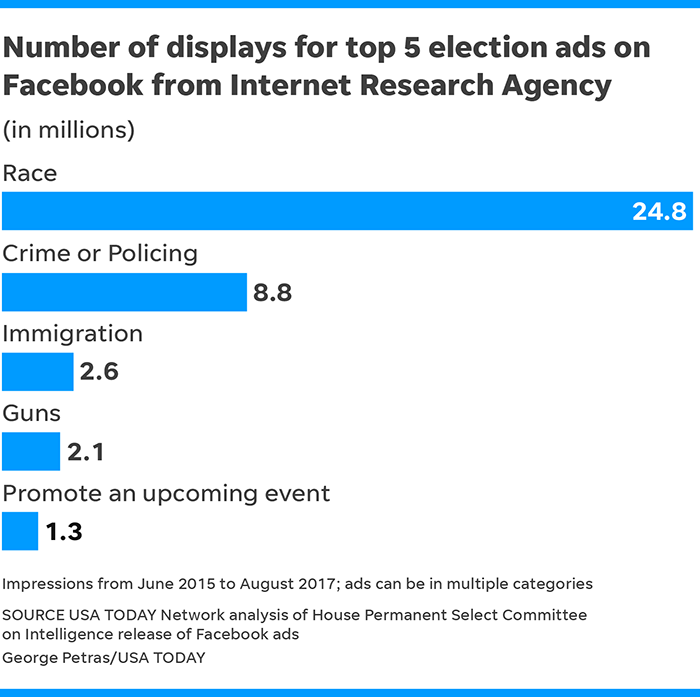Supercoolmayo
Superstar
The Russian company charged with orchestrating a wide-ranging effort to meddle in the 2016 presidential election overwhelmingly focused its barrage of social media advertising on what is arguably America’s rawest political division: race.
The roughly 3,500 Facebook ads were created by the Russian-based Internet Research Agency, which is at the center of Special Counsel Robert Mueller’s February indictment of 13 Russians and three companies seeking to influence the election.
While some ads focused on topics as banal as business promotion or Pokémon, the company consistently promoted ads designed to inflame race-related tensions. Some dealt with race directly; others dealt with issues fraught with racial and religious baggage such as ads focused on protests over policing, the debate over a wall on the U.S. border with Mexico and relationships with the Muslim community.
The company continued to hammer racial themes even after the election.
USA TODAY NETWORK reporters reviewed each of the 3,517 ads, which were released to the public this week for the first time by the House Permanent Select Committee on Intelligence. The analysis included not just the content of the ads, but also information that revealed the specific audience targeted, when the ad was posted, roughly how many views it received and how much the ad cost to post.
Among the findings:
Interactive Graphic: Explaining Russia's Facebook campaign aimed at Americans
- Of the roughly 3,500 ads published this week, more than half — about 1,950 — made express references to race. Those accounted for 25 million ad impressions — a measure of how many times the spot was pulled from a server for transmission to a device.
- At least 25% of the ads centered on issues involving crime and policing, often with a racial connotation. Separate ads, launched simultaneously, would stoke suspicion about how police treat black people in one ad, while another encouraged support for pro-police groups.
- Divisive racial ad buys averaged about 44 per month from 2015 through the summer of 2016 before seeing a significant increase in the run-up to Election Day. Between September and November 2016, the number of race-related spots rose to 400. An additional 900 were posted after the November election through May 2017.
- Only about 100 of the ads overtly mentioned support for Donald Trump or opposition to Hillary Clinton. A few dozen referenced questions about the U.S. election process and voting integrity, while a handful mentioned other candidates like Bernie Sanders, Ted Cruz or Jeb Bush.
Young Mie Kim, a University of Wisconsin-Madison researcher who published some of the first scientific analysis of social media influence campaigns during the election, said the ads show that the Russians are attempting to destabilize Western Democracy by targeting extreme identity groups.
“Effective polarization can happen when you’re promoting the idea that, ‘I like my group, but I don’t like the other group’ and pushing distance between the two extreme sides,” Kim said. “And we know the Russians targeted extremes and then came back with different negative messages that might not be aimed at converting voters, but suppressing turnout and undermining the democratic process.”

More: Thousands of Facebook ads bought by Russians to fool U.S. voters released by Congress
More: Here's how Russian manipulators were able to target Facebook users
More: Read the special counsel's indictment of the Internet Research Agency
Background: Special counsel indicts Russian nationals for interfering with U.S. elections and political processes
The most prominent ad — with 1.3 million impressions and 73,000 clicks — illustrates how the influence campaign was executed.
Read more at https://www.usatoday.com/story/news...russians-accused-election-meddling/602319002/

 . This is a ploy to censor content on the internet. They will use this bullshiit scenario to have Congress propose a law that says only certain types of media are allowed to do this or that...do y'all really want that?..it's a ploy.
. This is a ploy to censor content on the internet. They will use this bullshiit scenario to have Congress propose a law that says only certain types of media are allowed to do this or that...do y'all really want that?..it's a ploy. You’re worried about this being used to censor the internet like polticians need reasons in order to pass laws. I’m old enough to have watched pols start numerous military conflicts and one generational war for no reason. Everything isnt some three card monte scam with an ulterior motive. We are at a point were people are so distracted, depressed, or disengaged that they are effectively self censored anyway.
You’re worried about this being used to censor the internet like polticians need reasons in order to pass laws. I’m old enough to have watched pols start numerous military conflicts and one generational war for no reason. Everything isnt some three card monte scam with an ulterior motive. We are at a point were people are so distracted, depressed, or disengaged that they are effectively self censored anyway.